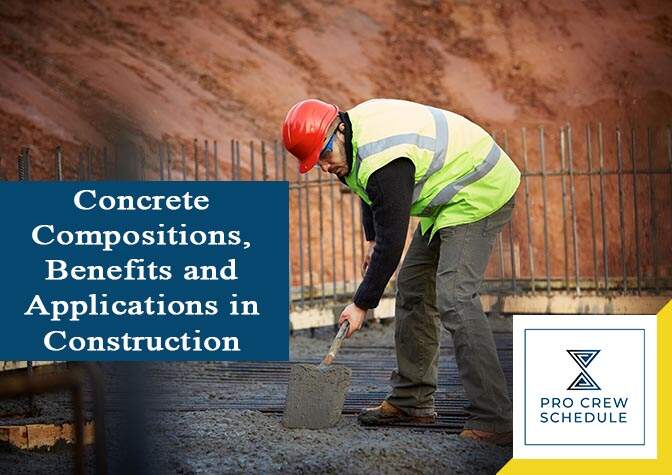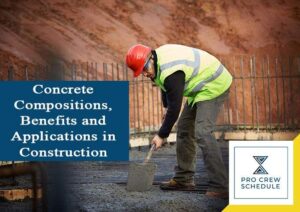This ever-evolving world needs continuous developing construction ways. At this present time, one of the most widely used construction materials is concrete. It isn’t because of the various options of applications that concrete offers; however, its strength, durability, flexibility and behavior play vital roles. Hence, contractors have faith in concrete as a simple yet strong and secure building material, especially for construction-building works.
Concrete is utilized in all building types, including residential spaces, multi-story workplace blocks, and infrastructure such as bridges, roads, etc. This material is the foundation of all modern developments, fortifying defenses against any natural disasters, putting roofs overheads of billions, and providing a structure for education, transport, healthcare, energy and industry.
In this blog, we’re going to dig deeper into details about concrete, including its basic compositions and numerous applications as a popular building material.
Concrete in Construction
Concrete, a synthetic stone-like mass, is a composite material made by mixing binding materials (lime or cement) alongside the aggregates, admixtures, water, etc., in any specific proportions. Concrete is a valuable and essential building material, especially for construction work. It plays a very critical role when it comes to construction projects.
When referring to concrete work, the common application is when using cast-in-place concrete. When managing construction, you’ll discover that foundations for structures are typically constructed of reinforced and formed footings, walls and piers or might be installed as earth bearings piles, or piles. Another way that concrete is being incorporated into construction is by utilizing pre-cast or tilt-up concrete structure due to the desire to accelerate schedule or construction space constraints, all while possibly enhancing quality control.
Concrete is easy to create, very powerful and can be formed into varied sizes and shapes. Additionally, this material is low cost, very reasonable and produces high-quality, fast-track construction. Any structures designed with a concrete unit of measurement are very durable, purposely designed to withstand hurricanes, earthquakes, and natural disasters.
Moreover, contractors know that construction projects are very highly structured endeavors. Every project has different facets, complexities and various tradesmen involved. That’s why there’s a need to employ project scheduling management software. This advanced application is dynamic and robust enough to carry the weight of your project.
Composition of Basic Concrete Mix
The strength of concrete is generally determined by the type and amount of its constituent materials. There are four basic ingredients that make up the concrete mix. The following discussion describes every mix component and how it affects the final product.
1. Binding material (cement or lime)
The primary element of the concrete mix is the binding material. The most commonly used binding material is cement. It provides durability and strength. Cement is often produced in many forms ranging from ground cement to several other cement types containing beneficial waste products from industries. Using and mixing such binding materials minimize the environmental impact.
2. Water
Water is a crucial element in the concrete specification design. The water will be initiating the chemical process of hydration with the cement, causing the mixture to strengthen and harden. The ratio of cement to water content will determine both the quality and strength of the finished concrete and the workability during the concrete pouring.
An increase in water content provides a more free-flowing concrete. However, it causes an adverse effect on the appearance and strength of the cast element. Concrete contractors have to note that too little water content can hinder the compacting process, thus increasing voids’ chances. When working with a team during the concrete mixing process, it’s crucial to monitor every crew’s tasks and performances.
Only by using a subcontractor scheduling software like Pro Crew Schedule that you can track and monitor your crew’s specific tasks and labor hours, of whether they complete their tasks or not.
3. Aggregates
Aggregates typically have two primary functions. One, they provide a firm structure in the concrete and two, they minimize void space to be filled by cement, a more expensive component. Both large and small aggregates are typically specified to enhance interlocking friction between various particles. Therefore, it improves the strength of the concrete. Also, locally sourced aggregates can lessen construction costs and integrate recycled concrete and waste products, once again minimizing environmental harm.
4. Admixtures
Admixtures are cautiously selected materials commonly used to modify the hardening and setting properties of concrete.
- Accelerators help develop early strength and increase the setting rate. This particular admixture is very useful when concrete is being cast in cold weather or improving construction speed.
- Plasticizers enhance workability. It allows the concrete mix to attain similar workability using less water. As a result, the concrete can develop much more excellent durability and strength. It also provides a better solution for concrete production in some regions with lower water supply.
- Retarders can reduce the setting rate. If retarders are applied directly to the formwork’s surface, the surface’s concrete is removed quickly, providing a visible aggregate surface finish.
- Air-entraining admixtures often release air bubbles into the mix, enhancing the concrete’s freeze-thaw resistance, specifically valuable for some areas with fluctuating environmental climates.
The Many Applications of Concrete in Construction
Since ancient times, concrete has always been used for construction. Concrete is specific to various applications like mending, rebuilding and construction. It is fascinating to note that over five billion tons of concrete are being produced every year. The following listed below are some applications of concrete.
1. Cast-in-place concrete
This ready-mix, unhardened state type of concrete is put into molds. This ready-mixed concrete is often mixed off and proportioned in the project site. It finds applications in slabs-on-ground, foundations, beams, columns, bridges, pavements, floors and other infrastructures.
2. Decorative purpose
The life prospect of concrete flooring materials is longer compared to several other flooring materials. It is utilized to improve concrete applications and add colors and texture to driveways, interiors, patios and pathways.
3. Building design
Concrete is being used to deliver extended building advantages by functioning as an acoustic barrier, thermal mass and durable structure. Over time, building designs become one of the factors that need more attention from the project leaders. Several other factors that aren’t mentioned are also given equal attention and meticulous planning. If any of these matters aren’t properly planned, the timeline for the project is compromised. Everything will only fall at the right place when you start using a cloud-based project management application.
4. Footings/Foundations
This building material is used as the primary foundation for many buildings and homes. For example, the concrete never rots or burn. Hence, everybody can ensure that the building’s foundation is durable and strong. Also, having a concrete basement provides extra protection during any natural disasters like bad storms.
5. Mid-Rise and High-Rise Buildings
Buildings made from concrete are commonly recognized to be much durable and safer compare to those made from other building materials and products. As a matter of fact, the NRCMA launched the Build with Strength campaign that focuses on the many advantages of using concrete, specifically housing structures. Concrete is the best choice for all sorts of construction applications.
Other Applications of Concrete
- Drain tiles, steps, and piers
- Post, deck and beams
- Round column forms and pilasters
- Hardscape pavers
- Brick ledge application
- High-performance admixtures
- Soil solidification
- Stucco Tilt-Up
- Masonry
- Insulating Concrete form
- Building structures, poles and fences
- Bases for gates and brick/block walls
- Overpasses and parking structures, motorways/roads
Over the years, concrete has continuously been established as a sturdy and durable building material for various applications. Moreover, the inherent benefits of utilizing concrete as a construction building material are too many to mention. Owing its basic properties, it’s not surprising that concrete is being used more than any other synthetic and man-made material on Earth.
Top Six Benefits of Using Concrete
Concrete is the only building material that profitably delivers:
1. The lowest carbon footprint either for a pavement or structure
The latest study from Canada finds that up to seventy-five percent of the carbon emissions, mainly from wood products, might currently be omitted from wood, and that’s when emissions are seriously taken into account. Concrete embodies carbon footprint for up to six percent less serious than that of wood products.
2. Unparalleled durability, strength, longevity and resilience
Concrete can last decades longer than any alternative building materials. It also gets stronger over time. It minimizes the overall cost of ownership and the environmental impact associated with all sorts of reconstruction or rehabilitation.
3. Maximized energy efficiency via thermal mass
Concrete’s capacity to store energy helps in moderating interior temperature conditions, minimizing the building’s cooling and heating demands over the service life by up to eight percent. It also enhances the building’s passive survivability, especially in the event services whenever heating fuel, water, or power are lost. As a result, it increases comfort for all occupants, reducing energy demands on the city.
4. Ideal for adaptive reuse
Due to concrete’s strength, fire resistance, and sound attenuation, a concrete building can easily be changed into other occupancy types during the service life. Reutilizing buildings in that way helps limit urban sprawl and contributes more to the conservation of resources.
5. Emission-free and versatile
An inert substance, once being cured, concrete is emission-free and will never emit any toxic compounds, gasses, or volatile organic compounds. While functional and solid when being hardened, the concrete’s plasticity when newly mixed lets contractors adapt it to any form, surface, texture and shape they can imagine. Latest innovations like ultra-high performance concrete (UCHP) and photocatalytic concrete also enable creative applications and new ways to use concrete.
6. Lower maintenance costs
Huge thanks to the concrete’s resilience, durability, energy efficiency, low maintenance requirements, concrete structures decreases operating costs for concrete buildings, specifically during the operating and construction phase.
Wrapping It Up!
No matter what type of construction project you’re about to handle, concrete will always be a great choice. Everyone in the industry agrees that concrete is the best building material that exists yet. And as the foundation for most construction, it is crucial to understand all aspects and formations of concrete from its basic concept to the overall completion to ensure high-quality work and installation.
High-quality work and services are also best achieved when you deploy one of the leading software in the market today – Pro Crew Schedule.
To be clear, almost sixty percent of the project costs come all from the materials used. Hence, managing the tools, equipment and inventory can significantly impact the overall profits and cost. Obviously, you’re going to use tons of materials, especially concrete, for the projects, pushing you to juggle a wide variety of moving parts. If you take shortcuts when dealing with your inventory, you’ll most likely become susceptible to expensive damages.
This is why you need strong inventory management software like Pro Crew Schedule to ensure your construction project’s successful completion. You can track and monitor your entire inventory across your desktop, tablet, and of course, app!
Feel free to request a LIVE demo to experience what Pro Crew Schedule offers!







